MIST
Magnetosphere, Ionosphere and Solar-Terrestrial
Nuggets of MIST science, summarising recent papers from the UK MIST community in a bitesize format.
If you would like to submit a nugget, please fill in the following form: https://forms.gle/Pn3mL73kHLn4VEZ66 and we will arrange a slot for you in the schedule. Nuggets should be 100–300 words long and include a figure/animation. Please get in touch!
If you have any issues with the form, please contact This email address is being protected from spambots. You need JavaScript enabled to view it..
Estimating Soft X-Ray Emission from Uranus's Magnetosheath
Estimating Soft X-Ray Emission from Uranus's Magnetosheath
By Dan Naylor (Lancaster University)
Soft X-rays can be generated within planetary magnetosheaths due to charge exchange between neutrals and highly charged solar wind ions such as O^7+. Imaging of the soft X-rays is an emerging technology that aims to provide global and dynamic views of the magnetosheath and cusps, and their response to solar wind driving. The ESA-CAS SMILE mission will soon be launched with a soft X-ray imager (SXI) instrument onboard to investigate the terrestrial magnetosheath. We explore the viability of similar investigations at Uranus.
Uranus has one of the most unusual and complex environments in the solar system. A large obliquity combined with a highly tilted, offset magnetic axis result in an asymmetric and constantly varying magnetosphere where the plasma and neutral source rates from the moons are unconstrained. We impose a simple bullet shaped magnetopause and moon tori informed by Voyager 2 observations to predict soft X-ray emission from the Uranian magnetosheath. We estimate volumetric emission rates of soft X-rays are on the order of 10^-10 photon cm^-3 s^-1, being higher at equinox due to the orientation of the magnetosheath relative to the moon tori. Simple estimates of intensity and flux find that a SMILE-like instrument could detect ~100 photons in a quarter of a planetary rotation at a distance of 212 R_U, as shown in the figure. A hypothetical future imager, with improved FOV and effective area, would detect ~20,000 photons per planetary rotation at 100 R_U. These are promising initial results that suggest imaging of the magnetosheath is possible within key system timescales. Future studies will include magnetospheric cusps and a full range of solar wind ions, which are anticipated to increase emission rates.
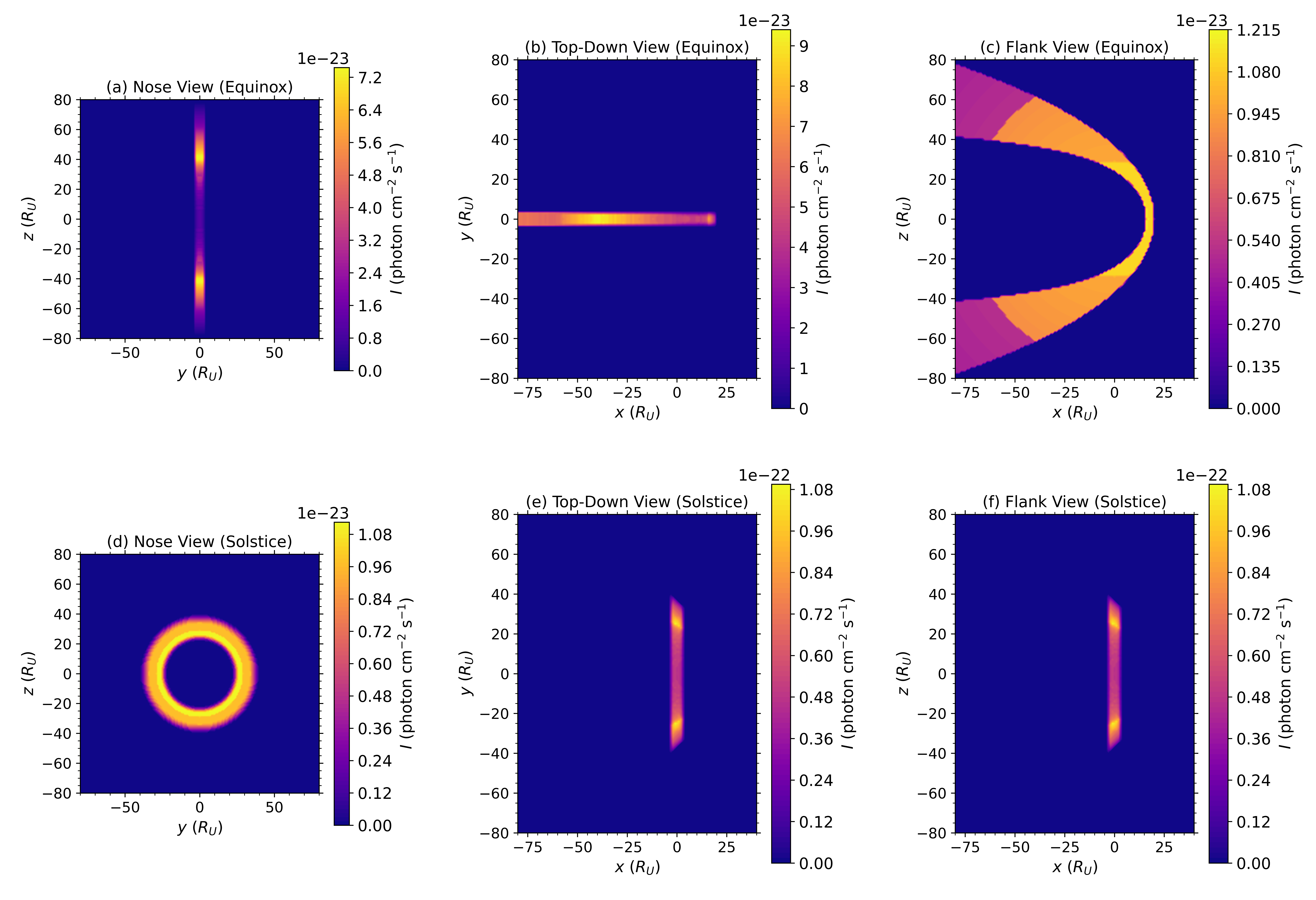
Modelled intensity maps for a SMILE‐like SXI at 212 R_U from different viewing geometries at (top row) equinox, where the neutrals are edge-on to the Sun, and (bottom row) solstice, where the neutrals are ring on to the Sun: (a/d) front‐on, (b/e) top‐down and (c/f) side‐on. The different panels show that the amount of flux detected is dependent on viewing position, and an orbital mission should consider the implications of different possible imaging positions.
See publication for details:
Naylor, D., Ray, L. C., Dunn, W. R., Jasinski, J. M., & Paty, C. (2025). Estimating soft X-ray emission from Uranus's magnetosheath. Journal of Geophysical Research: Space Physics, 130, e2025JA034171. https://doi.org/10.1029/2025JA034171
Omega Bands as a Source of Large dB/dt in the Dawn Sector
Omega Bands as a Source of Large dB/dt in the Dawn Sector
By Rosie Hodnett (University of Leicester)
Omega bands are a type of aurora which occur in the dawn sector and drift eastwards. They are often described as having a morphology similar to that of the Greek letter Ω. Omega bands have been shown to have the potential to cause geomagnetically induced currents, which are an important area of research as they are recognised as a hazard to our infrastructure, such as power grids.
In this study, we have examined an omega band event which occurred from 23 – 04 UT on 2012-11-13—14 using multiple instruments around Tromsø, Norway (69.6°N, 19.2°E). The first two panels (a-b) of the figure show EISCAT UHF/VHF electron density measurements, panel (c) shows a keogram of all-sky camera (ASC) data. It is clear that when the luminous aurora passes over head, enhancements in electron density are observed.
Panel (d) shows the magnetic field perturbations as measured by the IMAGE magnetometer and (e) shows dB/dt. For this event, we saw large perturbations in the Y component of the magnetic field, with a maximum peak of approx. 915 nT. The rapid motion of the omega bands leads to large dB/dt of above 10 nT/s.
Panel (f) shows AMPERE data, where the yellow dashed line is the location of EISCAT, where red is upward field aligned current (FAC) and blue is downward FAC. The auroral signatures and large dB/dt are evident when EISCAT is located between the boundary of region 1 and 2 current systems.
Panel (g) shows AL, where negative excursions due to the ground based magnetic perturbations of the omega bands are apparent. It is important that these rapid variations in AL are not misidentified as substorms, because as well as substorms, we have shown that omega band activity in the dawn sector causes drops in AL.
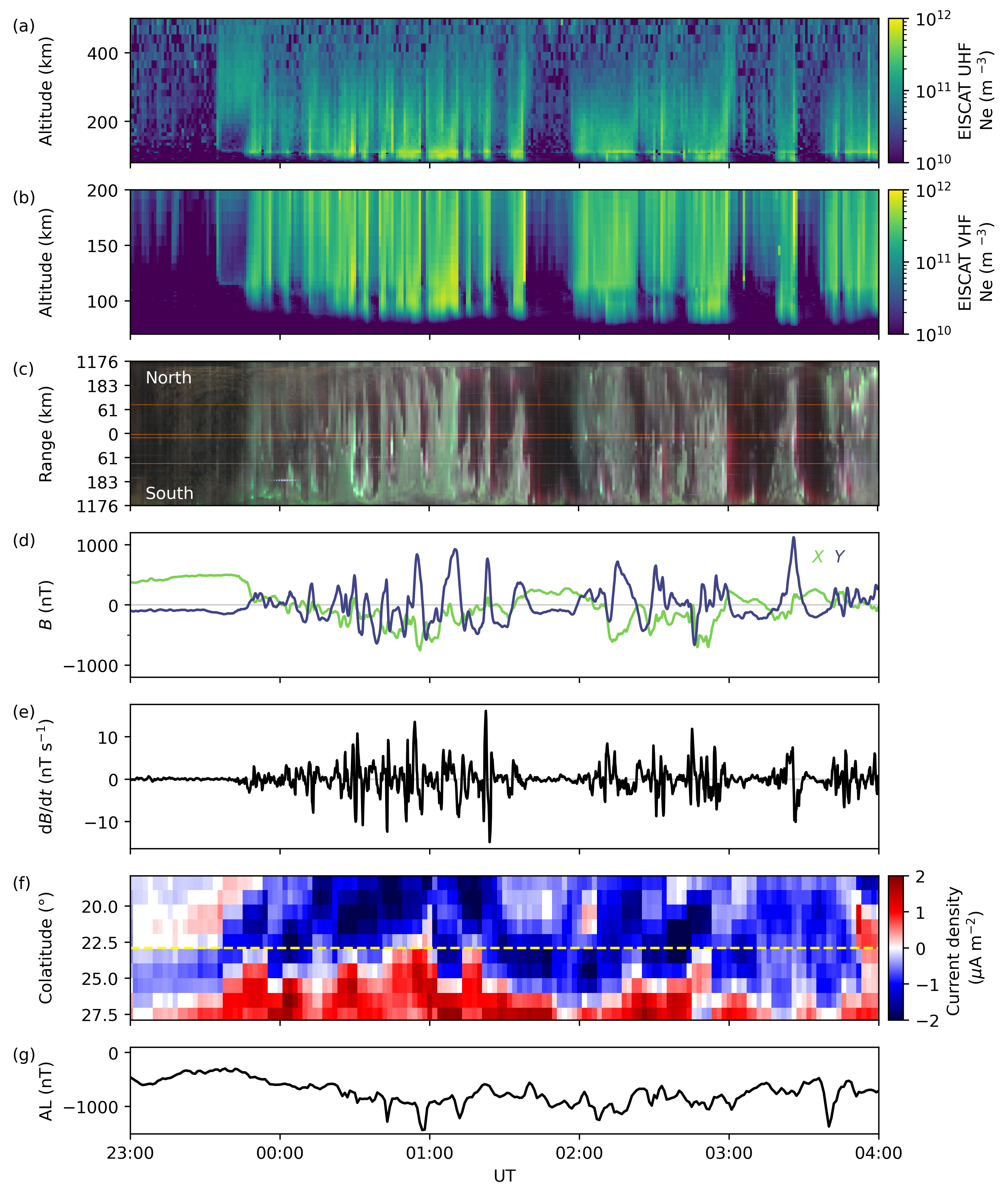
See publication for details:
Hodnett, R. M., Milan, S. E., Nozawa, S., Raita, T., Gjerloev, J. W., Vines, S. K., & Paxton, L. J. (2025). Omega bands as a source of large dB/dt in the dawn sector. Journal of Geophysical Research: Space Physics, 130, e2025JA034342. https://doi.org/10.1029/2025JA034342
Polytropic Analysis of Large-scale Compressive Fluctuations in the Solar Wind: Fluid and Kinetic Behavior
By Ioannou Charalambos (University College London)
Large-scale compressive plasma fluctuations are a minor component of solar wind turbulence but still significantly shape the turbulent cascade. They perturb the pressure and internal energy of the plasma, and thus influence the evolution of the solar wind’s bulk properties (i.e., density, temperature) and can subject the plasma to various large-scale temperature anisotropy and beam instabilities. Observations of the solar wind show that these fluctuations are typically characterized by an anticorrelation between the plasma density and the magnitude of the magnetic field, and thus share polarization properties with slow waves. The nature of the slow modes in the solar wind with respect to the polarization properties of the plasma has been found to be in better agreement with the magnetohydrodynamic (MHD) slow mode predictions compared to that of the kinetic slow mode.
The polytropic behaviour of the plasma in compressive fluctuations may provide further insight into the nature of the slow mode, since the MHD, Chew–Goldberger–Low (CGL), and kinetic slow modes predict different proton polytropic indices (γ). Using Solar Orbiter observations, we determine the effective polytropic index of protons and electrons for two compressive fluctuations events, and compare them with the theoretical expectations of MHD, CGL, and kinetic slow modes. The first event exhibits characteristics of the MHD slow mode (γp ≈ 1.7) while the second event is more consistent with the kinetic slow mode (γp ≈ 3). We show that the Coulomb collisionality of the first event is stronger than the second event which may explain the different behaviour between the two events. Additionally, multiscale analysis shows that nature of the two events does not change significantly with scale. However, a scale dependence is observed for both events that suggests that kinetic effects become more prominent at smaller scales.
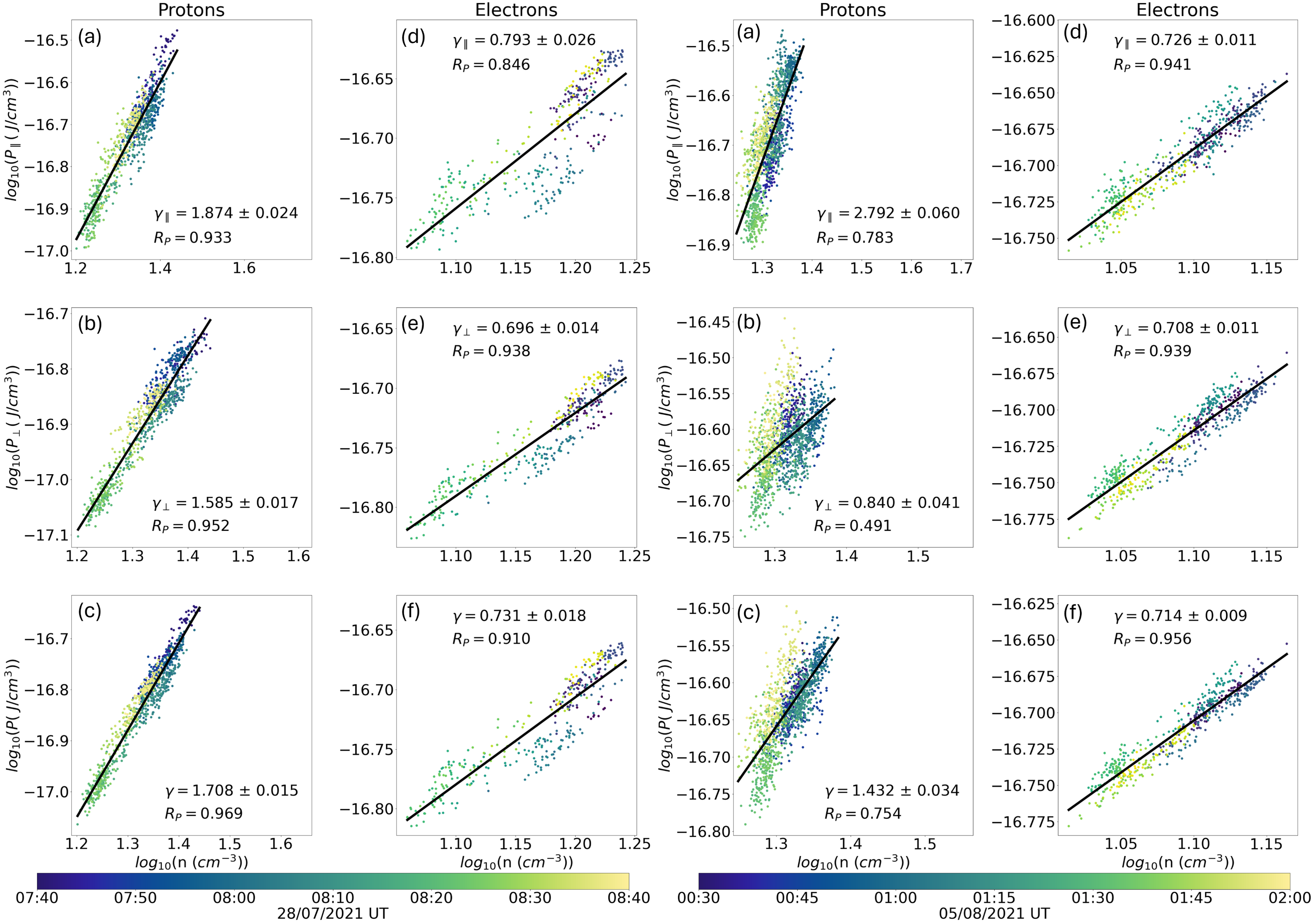
Polytropic index results for protons and electrons in the first (left) and second (right) compressive fluctuations events. R_p is the Pearson correlation coefficient. Panels (a)–(c) show the proton results and panels (d)–(f) show the electron results. Panels (a) and (d) show the parallel, panels (b) and (e) the perpendicular, and panels (c) and (f) the isotropic polytropic index results. The colour of the data points represents the time instance of the corresponding measurement in the interval. The first event shares characteristics with the MHD slow mode with an isotropic proton polytropic index of γ_p ≈ 5/3, while the second event shares characteristics with an Ion Acoustic wave with a parallel proton polytropic index of γ_(∥p) ≈ 3
See publication for details:
Ioannou, C. et al. (2025) ‘Polytropic Analysis of Large-scale Compressive Fluctuations in the Solar Wind: Fluid and Kinetic Behavior’, The Astrophysical Journal, 988(2), p. 253. Available at: https://doi.org/10.3847/1538-4357/adeb7b
Ubiquitous threshold for coherent structures in solar wind turbulence
By Alina Bendt (University of Warwick)
The solar wind may be heated by turbulence. Coherent structures which are one possible mediating mechanism of the turbulent cascade may dissipate energy. The partial variance increment (PVI) is routinely used to characterize and identify coherent structures. Previously the threshold beyond which fluctuations may be coherent structures was identified by comparisons to a Gaussian distribution. We compare wavelet decompositions with the Haar and 10th-order Daubechies wavelets to determine the threshold from the physical character of the fluctuations. These wavelets are sensitive to sharp changes and oscillations in the time series respectively. Comparisons of the fluctuation distributions obtained from these two wavelets reveal a core and tail., the latter is dominated by coherent structures. The transition from core to tail identifies the PVI threshold. This threshold coincides with the PVI value where the PVI distributions obtained from the Haar and Db10 wavelets start to depart from each other. We find a single value for the threshold in each the kinetic and inertial ranges. This threshold is independent of heliocentric distance and solar wind conditions. The detailed behaviour of the fluctuations above the threshold varies, reflecting different ways that turbulence develops with distance from the sun. This suggests an underlying mechanism governing these coherent structures that is the same regardless of the specific plasma conditions.
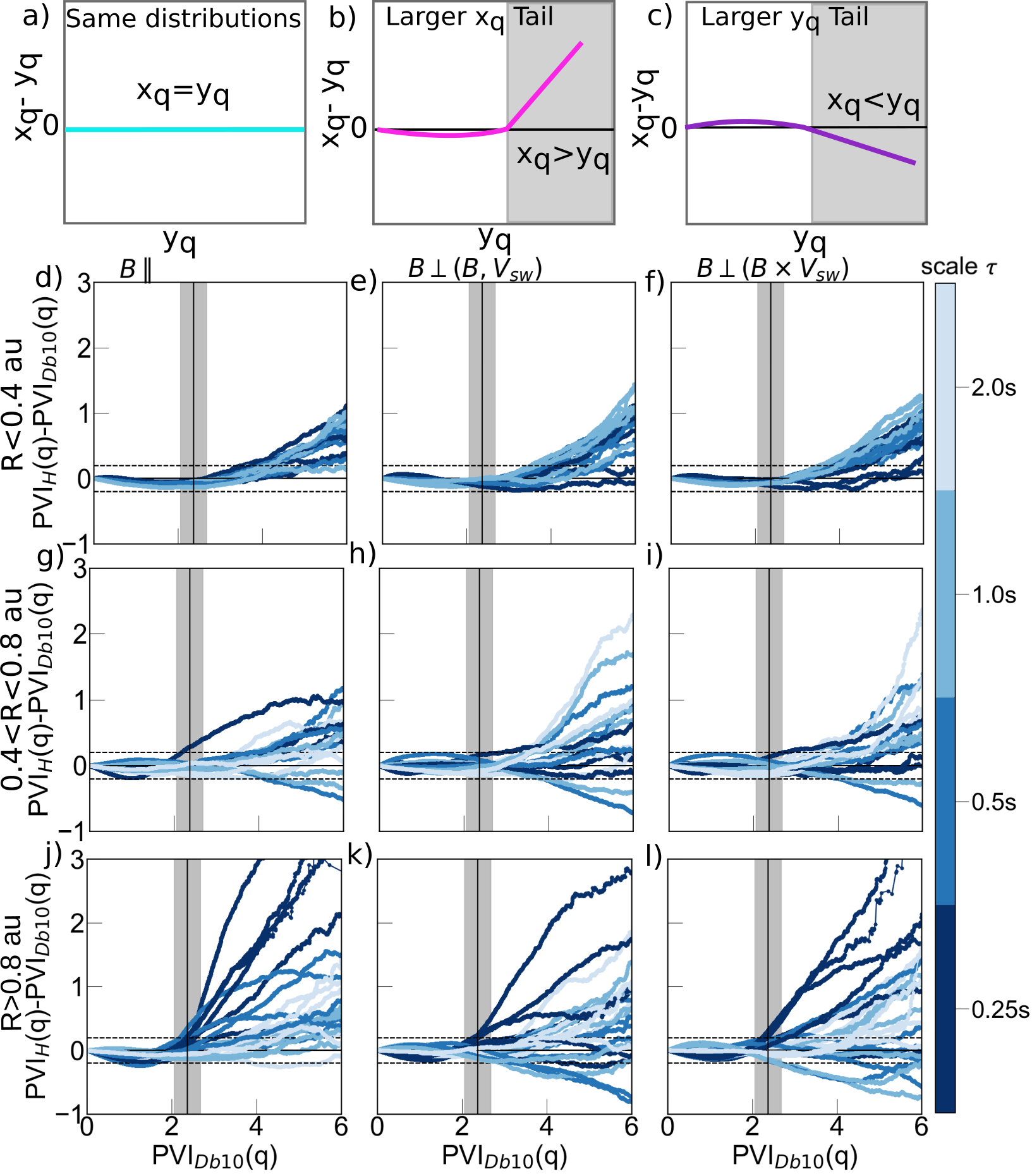
Compensated Quantile-Quantile (QQ) plots discriminate where the Haar (sharp changes) and Db10 (wave-packet) decomposed PVI fluctuation distributions diverge (gray shading) for all solar wind intervals in the kinetic range. The upper panels [(a)–(c)] illustrate the compensated QQ plots. [(d)–(j)] are compensated QQ plots in the kinetic range overplotted for all intervals. These are divided into three categories based on heliocentric distance, (i) 0.3 R < 0.4 au, (ii) 0.4 < R < 0.8 au, and (iii) R > 0.8 au (rows), shown for all magnetic field components (columns). The different scales τ are color coded from dark blue (0.25 s) to light blue (2 s). The overplotted PVI threshold of 2.2 (marked by a black vertical line) is the same for all panels, capturing where the Haar and Db10 derived PVI distributions diverge. The gray shaded region determined from the variance of the threshold ranges from 2.1 to 2.7. This threshold is independent of the scale τ of the turbulence and heliocentric distance. Dashed horizontal lines are at PVI ±0.2 for reference.
See publication for details:
Bendt & Chapman (2025) Ubiquitous threshold for coherent structures in solar wind turbulence, Phys. Rev. Research, doi:10.1103/PhysRevResearch.7.023176
Quantifying the number of false positive substorms identified in the SuperMAG SML index arising from enhancements in magnetospheric convection
By Christian Lao (MSSL, University College London)
Substorms can be identified from negative bays in the SML index, which traces the minimum northward ground magnetic deflection at auroral latitudes, produced by enhancements of the westward electrojet. For substorms, negative bays are caused by the closure of the Substorm Current Wedge through the ionosphere, typically localized to the nightside and centred around 23-00 magnetic local time (MLT). In this case, the equivalent current pattern that causes the magnetic deflections is given the name Disturbance Polar (DP) 1. However, negative bays may also form when the westward electrojet is enhanced by increased convection, driving Pedersen and Hall currents in the auroral zone. Convection enhancements also strengthen the eastward electrojet, monitored by SMU index. In this case, the equivalent current pattern that produces the magnetic deflections is called DP2.
In this study, we investigated the contributions of the magnetic perturbations from the DP1 and DP2 current patterns to substorm-like magnetic bays identified in SML using the SOPHIE technique of Forsyth et al. (2015), https://doi.org/10.1002/2015ja021343. SOPHIE attempts to distinguish between the DP1 and DP2 enhancements, whereas other SML-based substorm identification methods don’t (e.g. Newell & Gjerloev, 2011; Ohtani+, 2020; etc). However, despite this, we find evidence that between 1997 and 2019 up to 59% of the 30,329 events originally identified by SOPHIE as substorms come from enhancements of DP2, which are unrelated to substorm phenomena, on top of the 2,627 convection enhancement events already identified. We highlight that any “substorm” list is, in fact, a list of magnetic enhancements, auroral enhancements, etc., which may or may not correspond to substorm activity and should be treated that way.
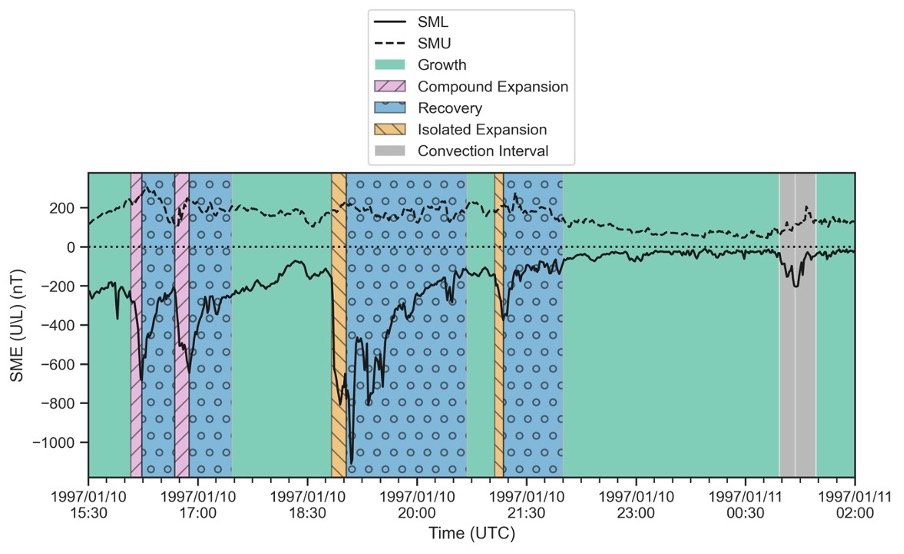
See publication for details:
, , , & (2025). Separating DP1 and DP2 current pattern contributions to substorm-like intensifications in SML. Journal of Geophysical Research: Space Physics, 130, e2024JA033592. https://doi.org/10.1029/2024JA033592